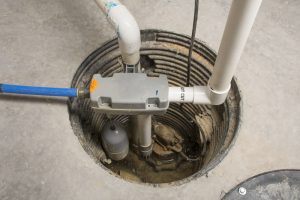 Sump pumps are a staple item in our area during the stormy season. They help prevent water infiltration into homes due to flooding or a plumbing pipe burst, working automatically as they gather excess water in a pit (the sump) and pump it out into either your wastewater system or a well.
Sump pumps are a staple item in our area during the stormy season. They help prevent water infiltration into homes due to flooding or a plumbing pipe burst, working automatically as they gather excess water in a pit (the sump) and pump it out into either your wastewater system or a well.
Homes throughout Ashburn and beyond often have crawlspaces and basements. And when these areas suffer from flooding, it can lead to severe property damage and unhealthy mold and bacteria growth. The last thing you need to worry about is replacing drywall and wood support beams or even replacing appliances you keep down in the basement when you have poor weather. We recommend not only having a sump pump, but keeping it in good shape, too. How? By testing it to make sure it works.
Testing Your Sump Pump
First, how often should this happen? We say once a quarter is a good guideline to follow. On top of that, however, you should test your sump pump after each storm that introduces water to your property. You don’t want to have a broken pump and not know about it!
Fortunately, it’s relatively easy to test a sump pump. The first step is checking to ensure that it has power and that it turns on automatically. To check this, you’ll want to find the outlet where the sump pump is plugged in. Go ahead and unplug it and plug it back in—kind of like a “reboot” for the system. If the sump pump turns on, you’re good so far. If it doesn’t, however, you already know something is amiss and it’s time to call our plumbers.
Next, pour water into the sump—that is, the actual pit where the water collects. Be sure to clean out the sump of any debris before doing this. This can include rocks, gravel, leaves, etc. You want your sump to be as clean as possible. Then pour a few gallons of water down into the sump.
If your sump pump is a pedestal pump—positioned above the sump—watch the float in the sump as the water raises it. This should cause the pump to cycle on. If, however, the pump is submersible—the pump is down in the sump itself—then the pump should turn on once the water reaches above the intakes.
Keep in mind: your job isn’t done here. Just because the pump turns on does not mean it’s working as it should. Keep watching the pump to see that it actually expels water.
We have to share a word of caution here: a sump pump motor is designed for use with water. If you test the pump without water, you should only let the motor run for a few seconds before shutting it off. You may damage the motor if you let it run longer.
If your sump pump isn’t working as it should, be sure to call our pros for a repair. Fixing a sump pump is something that should be left to those who are trained to deal with it to avoid further problems.
Contact AllTech Services, Inc. today for quality Ashburn plumbing services!

